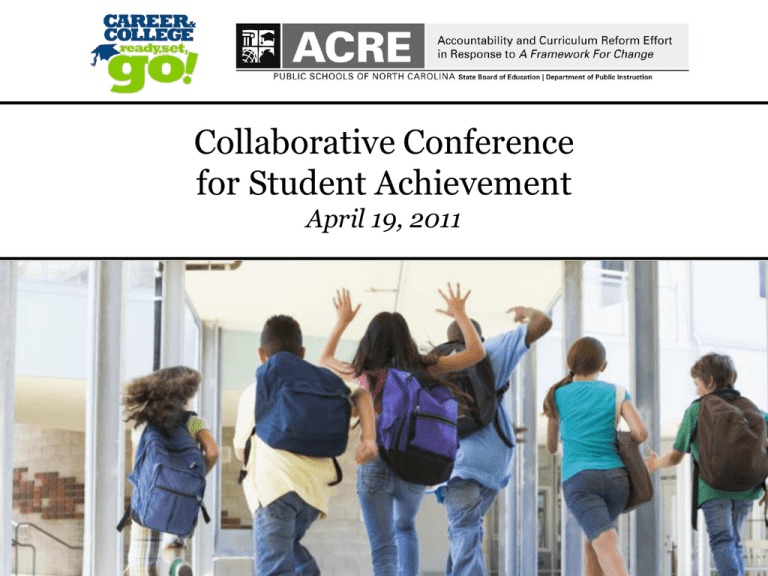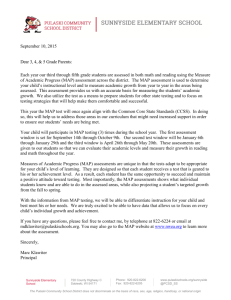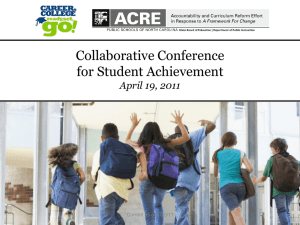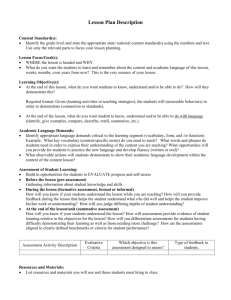Collaborative Conference for Student Achievement
advertisement

Collaborative Conference for Student Achievement April 19, 2011 1 1 Blue Ribbon Commission Report SBE’s Framework For Change NCDPI’s Response to Framework For Change Essential Standards Assessments Accountability PROJECT MAP Newer ACRE work streams connecting directly with teachers, leaders, parents and students Tools and training, blending online and faceto-face learning experiences. Professional Development Standards Ongoing central work to revise standards, assessment and accountability Newer work to deliver new standards, assessments and teaching tools Newer work to build LEA capacity to implement online tools 2010-11 Communication & Change Management Assessment College and career-ready standards. A new set of academic standards benchmarked against the best national and international expectations. Summative Benchmark Formative A comprehensive assessment system with a focus on using assessments to improve instruction and fairly assess learning and instructional effectiveness. Diverse communication strategies that memorably inform all stakeholders esp. students, parents, teachers, principals. Accountability A revised model that includes measures of postsecondary readiness, robust, fair growth measures, revised reporting functions and motivates behavior that improves student outcomes. Instructional Improvement System (IIS) User-friendly online platform to house and deliver teacher tools Instructional Technology and Infrastructure Initiatives Standards College and career-ready standards. A new set of academic standards benchmarked against the best national and international expectations. The goal is to set fewer, clearer and higher standards that, when achieved, ensure a student is ready for postsecondary education and work. Standards include Common Core in ELA and Math and NC Essential Standards in all other subjects. Curricular support resources will be developed to support the transition. Time Line Subject Area English Language Arts Mathematics Science Social Studies, Healthful Living, Arts, Guidance, World Languages Career and Technical Education Information and Technology Skills Early Learning Extended Content Standards Where is NC in the adoption process? 2010-2011 School Year 2011-2012 School Year 2012-2013 School Year Common Core adopted June 2010 Current taught and assessed Current taught and assessed Common Core taught & assessed Common Core adopted June 2010 Current taught and assessed Current taught and assessed Common Core taught & assessed Essential Standards adopted February 2010 Social Studies, World Languages and Arts adopted; Healthful Living and Guidance in Winter 2011 Current taught and assessed Current taught and assessed New Essential Standards taught & assessed Current taught and assessed Current taught and assessed New Essential Standards taught & assessed Anticipated adoption January 2011 Current taught and assessed Current taught and assessed New Essential Standards taught & assessed New Essential Standards taught New Essential Standards taught Current taught New Essential Standards taught New Essential Essential Standards Standards adopted September 2009 piloted with current Anticipated adoption of Essential Standards: Current taught Spring 2011 All Extended Content Standards will be on the same operational time line as the standards in each individual content area. Overview of the Common Core Initiative o State-led and developed Common Core Standards for K-12 in English Language Arts and Mathematics o Focus on learning expectations for students, not how students get there Similar Goals for Standards North Carolina’s Mandates “Essential” “Narrow” “Deep” “Rigorous + Relevant” “Readiness for College and Career” “Enduring” “Measurable” “Clear and Concise” “Prioritized and Focused” Common Core “Essential” ”Fewer, Higher, Clearer” ”Focused” ”Rigorous” ”Readiness for College and Career” Common Core Rationale o Equity Students expectations the same regardless of where they live o College and Career Readiness Students need to be more than proficient o Comparability State results will be comparable through common assessments o Sharing of Resources The ability to share instructional materials across state lines can improve practice o Economies of Scale Possible savings due to sharing of resources and assessments o Student Mobility Students moving into and out of states will have the same standards June 3, 2010 SBE Adoption of the Common Core Standards www.corestandards.org ELA Standards Advances o Text complexity o Balance of literature and informational texts o Direct link to college and work readiness o Literacy standards for science and social studies o Clear vertical progressions across grades Math Standards Advances o Focus in early grades on number (arithmetic and operations) to build a solid foundation in math o Evened out pace across the grades o High school math focus on using math and solving messy problems, similar to what would see in the real world o Problem-solving and communication emphasized Tools and training, blending online and face-to-face learning experiences to help educators increase effectiveness and transition to new standards and assessments. Included are the creation of instructional toolkits, NC Falcon formative assessment training modules, new standards roll-out, using data to make decisions and Response to Instruction. Professional Development Professional Development for Teachers and Leaders Tools & Professional Development Online for Teachers and Leaders Face-to-Face Professional Development “ A combination of online and face-to-face learning that includes different combinations of technologies, pedagogies, and contexts.” (Graham, 2006; Stacey & Gerbic, 2001; Garrison and Vaughn, 2008) Face to Face Virtual RESA Partnership Online modules Conferences Professional Development System Summer Institutes Virtual PLCs Assessment Summative Benchmark Formative A comprehensive assessment system with a focus on using assessments to improve instruction and assess learning and instructional effectiveness. Plan includes updated EOG and EOCs, a tool to build common benchmark assessments and a variety of formative assessment tools including progress monitoring tools, writing assessments, in-class formative assessment training, portfolio assessments and data tools to improve instruction. Next Generation Assessments • A comprehensive balanced assessment system • Updated EOG and EOCs (online, innovative item types, computer adaptive) • Tools to build common benchmark assessments and a variety of formative assessment tools • Data tools to improve instruction Comprehensive Balanced Assessment System Formative Assessments: A process used by teachers and students during instruction that provides feedback to adjust ongoing teaching and learning to help students improve their achievement of intended instructional outcomes. Formative Assessment includes: •Questioning •Discussions •Learning Activities •Feedback •Conferences •Interviews •Student Reflections Classroom Summative Assessments: A measure of achievement to provide evidence of student competence or program effectiveness Summative Assessment includes: • Selected Response Items Multiple-Choice True/False Matching • Short Answer Fill in the Blank 1-2 Sentence Response • Extended Written Response • Performance Assessment Statewide, Benchmark, and Classroom Online EOCs and EOGs NC is moving towards online only assessments, accessed through the IIS (by 2014-2015). Online assessments will allow the state to incorporate technology-enhanced items and implement computer adaptive testing, which will allow for a more accurate assessment of student learning. Support for moving to online assessments includes working with LEAs/Charter Schools to ensure that schools have the logistical and technical knowledge and skills to move rapidly to an online testing environment and a Best Practices Guide for Online Assessments (July 2011). Online EOCs and EOGs NOW: All EOCs are available online; All LEAs are expected to participate 2012/2013: While all EOCs will be available online, the following assessments will be developed specifically for an online environment, some with technology-enhanced items. LEAs are encouraged to complete them online. EOG Science at Grades 5 and 8 NCEXTEND2 Science at Grades 5 and 8 NCEXTEND2 Mathematics and ELA Grades 3-8 EOC English I EOC Algebra I EOC Biology NCEXTEND2 English I NCEXTEND2 Algebra I NCEXTEND2 Biology 2014/2015: The plan is to have all EOCs/EOGs developed specifically for an online environment with limited use of an alternate paper and pencil version. Instructional Improvement System (IIS) Single, user-friendly online platform to house and deliver new tools, particularly the delivery of formative and summative assessments, provision of data analysis tools, delivery of professional development and instructional resources to teachers and establishment of online learning communities. Instructional Improvement System (IIS) The IIS will be: • An online resource • An integrated repository of shared tools and applications • A tool to help educators improve instruction • A device to integrate data from multiple sources, including NC WISE IIS Tools Tools will be available for managing formative assessment, student work and organizing classroom activities. Student Artifact Repository for evidence of learning such as digital work, including documents, video files, photographs, etc. Classroom and Instruction Management Tools (potential tools) Classroom grouping, organization, and seating tools. Tools to document use of formative assessment such as teacher observations about student skill and behavior. Grade management tools, such as grade books, student work reports, etc. IIS Tools for Teachers The Educator Evaluation System will be available, with direct links to professional development modules. Leadership Respectful environments Educator Evaluation System Content knowledge Facilitating learning Reflective practice Professional Development Modules (e.g., NC FALCON) IIS Assessment Tools The assessment tool can be used to create classroom, grade, or LEA assessments. Test Generator High-quality Item Bank Assessments scored online, using: • artificial intelligence • scoring rubrics Secure item pool Non-secure item pool LEAs create assessments Teachers create assessments Variety of item types, including: open-ended technology-enhanced multiple-choice scenario-based 3/22/2016 Can be used with: • student response “clickers” • handheld devices IIS Timeline (Key Dates) IIS Tool Release Date Assessment Tool Science/Social Studies July 2012 ELA/Math January 2013 Data Dashboard Phase I July 2012 Phase II (optional…) January 2013 Digital Artifact Repository January 2013 Data Guides Using Data for Instruction December 2011 Best Practices for Using the IIS July 2012 Accountability A revised model that includes measures of post-secondary readiness, robust, fair growth measures, revised reporting functions and motivates behavior that improves student outcomes. Indicators Student Achievement Based on authentic assessments Post-Secondary Readiness Metric to be determined Student Growth Graduation Rates Math Course Rigor Robust measures using more historical data 5-year Cohort Students meeting the Future-Ready Core requirements Growth Index Matrix Lower Performance Higher Growth Higher Performance Higher Growth Lower Performance Lower Growth Higher Performance Lower Growth Performance Index Uses Report Reward and Sanction Target Assistance Levels at which indicators might be used Student o Revised Student Accountability Classroom o RttT and Educator Effectiveness Workgroup o Teacher Evaluation Tool School LEA State o Much is decided; key issues remain outstanding Decisions School • Future-Ready Core Inclusion LEA • More Robust Growth Model • Five-Year Grad Rate • Index System (including bonus points) • Student Accountability Updated State Outstanding Issue • Post-Secondary Readiness





